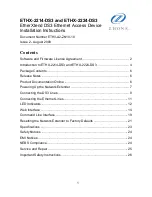
BIPAC-74x
Series Router – 741 GE, 741 GE V2.0 and 743 GE
Chapter 3: Basic Installation and Configuration
LLC:
This setting allows you to enable/disable whether your system can transmit and
receive packets containing LLC headers.
Lcp Max Configure:
Link Control Protocol; the maximum number of configuration
attempts that can be transmitted without reply before assuming that the destination
address is unable to respond.
Lcp Max Failure:
Link Control Protocol; the maximum number of consecutive negative
acknowledgements (indicating that the information received contains errors) that can be
transmitted before assuming that parameter negotiation is not converging. It can be any
positive value.
Lcp Max Terminate:
Link Control Protocol; the maximum number of consecutive
Terminate Requests that will be sent without reply before assuming that the destination
address is unable to respond. It can be any positive value.
Dial Auth:
Sets the authentication method that remote PPP clients must use to dial in to
the server.
Dialout Username:
A name that identifies a user and, together with the dialout password,
enables a user to login to the remote end. The username will be required by the PPP
server when the user wants to login remotely. It can be made up of one or more characters
and/or digits.
Dialout Password:
An arbitrary word that acts as a dialout password enabling you to login
to the remote end. The password will be required by the PPP server when you want to
login remotely. It can be made up of one or more characters and/or digits.
Dialout Auth:
Sets the authentication protocol used to connect to external PPP servers
(dialout).
Local IP:
Tells the PPP process the local IP address to be associated with the client-end
of an interface.
Remote IP:
Sets the IP address supplied to the remote end of the PPP connection during
negotiation. This is particularly important for PPP dial in transports.
38
Magic Number:
This value is for establishing and identifying the PPP link. This is used in
















































